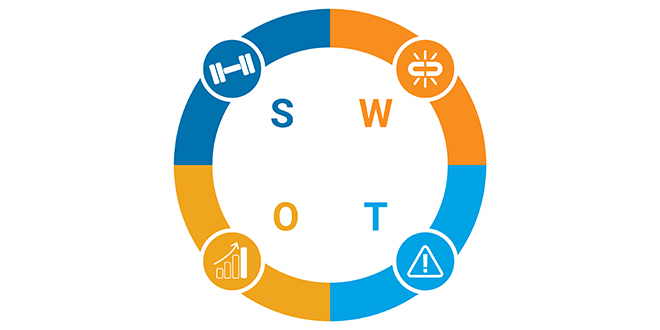To read Hardware Retailing’s analysis of Lowe’s strengths, weaknesses, opportunities and threats, click on the icons below and scroll down. Read the full Lowe’s 360 profile here.
Strengths
Size. Being large gives Lowe's the benefits of economies of scale, massive buying and price negotiating power, long-standing relationships with manufacturers, 1,977 store locations in the U.S. and Canada, a strong supply chain and significant brand recognition.
Alliances. Partnerships strengthen Lowe's position in the minds of consumers and professional customers.These include collaborations with the NFL and property and asset management software company Yardi, as well as with other large corporations through Lowe's Generation T trades program.
Price Image. The company has a reputation for offering low prices in the home improvement industry, benefiting from the big-box image of being inexpensive even when its prices aren't lower than competitors.
New Leadership. A group of new, but highly experienced, top executives, led by CEO and president Marvin Ellison, is reevaluating company initiatives and has the motivation and momentum to bring extensive improvements.
Steady Sales Growth. Lowe's stores have seen consistent year-over-year sales growth for at least three decades, with only slight dips in 2008 and 2009 due to the economic downturn in 2008. Sales surpassed pre-recession levels in 2010 and have been on an upward trajectory ever since.
Wide Product Assortment. Individual Lowe's stores typically stock about 35,000 products each. The company appeals to consumers who have a preference for a one-stop shop for project supplies and also provides an array of brand-name products that appeal to pros and DIYers who are brand loyal.
Fresh Focus on Pros. Professionals spend significantly more money per year at Lowe's stores than DIY customers, so a renewed focus on serving pros better is a good move for the company to grow sales.
Weaknesses
Lost Focus on Pros. Originally a primarily pro-serving business, Lowe's has lost its lead in serving pro customers, supplanted by Home Depot as professional customers' destination for buying full projects' worth of supplies. Lowe's now has a reputation to rebuild with pros.
Side Projects. Lowe's has dabbled in expensive side projects that have detracted from its core business. Shutting down operations in Australia and Mexico and reducing its footprint in Canada, as well as shedding its Orchard Supply Hardware chain in the U.S., have been costly.
Size. Company size can be a weakness if Lowe's is unable to adapt rapidly enough to meet customers' needs in an evolving retail environment.
Locations. Lowe's has a history of building stores in rural areas, which has pros and cons. Rural locations tend to serve a less affluent customer base. The company also began operating prior to Home Depot, so it has had comparative disadvantages due to having some older, retrofitted buildings and locations that are no longer prime for development.
E-Commerce. Lowe's has long had an outdated online selling platform and has been behind general retail and Home Depot in building the robust e-commerce presence customers expect and a supply chain to support it.
Customer Service. Like other big-box stores, Lowe's has a reputation for customer service that is less personal and less helpful than independent stores provide. An outdated e-commerce site and poor execution of its buy online, pickup in store and home delivery options enforce a less-than-stellar customer service image.
Business Seasonality. Weather impacts Lowe's operation heavily due to the retailer's reliance on selling seasonal goods, such as lawn and garden products in the spring and snow clearing equipment in the winter.
Opportunities
Professional Customers. On average, professional customers spend more money at home improvement businesses compared to consumers. Lowe's has opportunities to improve relationships with existing professional customers and attract new pros through an expanded pro loyalty program and its hiring spree to expand in-store staff to provide strong customer service to pros specifically. The company's efforts to promote skilled trades through an employee apprenticeship program and a program for high school students also show promise to improve its reputation with pro customers.
E-Commerce. Continuously updating its website and focusing on improving its e-commerce presence would improve Lowe's ability to compete in an arena where customers now expect a seamless multi-platform experience that includes websites, social media, mobile apps and in-store shopping.
Home Decor and Appliances. Both home decor and appliances are categories Lowe's already sells and has the opportunity to gain market share in. Other retailers, including Sears, J.C. Penney and Bed, Bath & Beyond, have dominated segments of those categories but are struggling to survive.
Expert Service. Home Depot has improved its customer service reputation in recent years and many independent retailers have made names for themselves by offering expertise and top-notch service. Lowe's could improve its service reputation and dramatically improve customers' experiences in stores by hiring experts in areas such as electrical and plumbing and improving employee training.
Supply Chain Investments. To support a growing e-commerce business and better serve pro and consumer store customers, Lowe's would benefit from making substantial supply chain upgrades. Home Depot has invested heavily in e-commerce and its supply chain in recent years and has reaped benefits Lowe's hasn't seen yet.
Threats
Major Big-Box Competitors. The home improvement sector has strong players. As the largest home improvement retailer in the U.S., Home Depot has long outpaced Lowe's in overall sales performance and cemented itself ahead of Lowe's in areas such as pro sales. Menards, though significantly smaller, is working to improve the omnichannel shopping experiences it offers and has set itself apart with a lowest-price reputation. General retailers, such as Walmart, and online retailers like Amazon also compete with Lowe's in some product categories and have changed customers' expectations for omnichannel shopping, fast delivery and pricing.
Cyber Threats. The more ways customers can engage with and buy from Lowe's digitally, the more risky data breaches could become. Having hackers steal customer data could result in lost customer trust, expensive lawsuits and lost sales.
Independent Retailers. In the home improvement industry, independent operators can adapt to changing customer needs and the evolving retail world more quickly than large corporations. In addition, they can provide hyper-local products and services and offer highly personalized customer service.
Socioeconomic Uncertainty. Lowe's has survived the Great Depression, 2008's economic downturn and multiple wars. However, a pandemic, riots, city curfews, political changes and other factors contributing to economic and social uncertainty could impact Lowe's ability to maintain and grow sales long term.
Supply Chain Interruptions. Lowe's ability to meet customers' expectations is dependent on the company's ability to source products when consumers and pros need them. Major logistics problems could damage Lowe's reputation and hurt its ability to grow.
 Hardware Retailing The Industry's Source for Insights and Information
Hardware Retailing The Industry's Source for Insights and Information








